

Directed by: David Hand
Written by: Felix Salten
Music by: Frank Churchill & Edward H. Plumb
Released on: August 13, 1942
Running Time: 69 minutes
Box-Office: $103 million in the U.S., $268 million worldwide
Bambi... Hardie Albright
Flower (Adult)... Sterling
Holloway
Thumper... Peter Behn
INTERESTING
FACTS
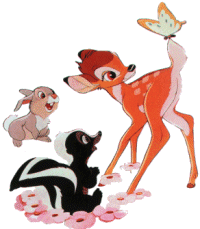
![]() Austrian author
Felix Salten (1869-1945) wrote the story of Bambi in 1923. The idea
came to him while on vacation in the Alps after being charmed by the wildlife
there. He based the name, Bambi, on the Italian word "bambino", meaning
baby. Bambi, ein Leben im Walde (Bambi, a Life in the Woods)
was published in Vienna in 1926, and translated in English two years later.
Austrian author
Felix Salten (1869-1945) wrote the story of Bambi in 1923. The idea
came to him while on vacation in the Alps after being charmed by the wildlife
there. He based the name, Bambi, on the Italian word "bambino", meaning
baby. Bambi, ein Leben im Walde (Bambi, a Life in the Woods)
was published in Vienna in 1926, and translated in English two years later.
![]() Maurice Day, an
animator with Disney, brought Felix Salten's book to the attention of Walt
Disney. When Walt decided to make the movie, he thanked Maurice Day by
holding the world premiere in Maurice's home town, in the tiny Lincoln
Theater of Damariscotta, Maine, USA.
Maurice Day, an
animator with Disney, brought Felix Salten's book to the attention of Walt
Disney. When Walt decided to make the movie, he thanked Maurice Day by
holding the world premiere in Maurice's home town, in the tiny Lincoln
Theater of Damariscotta, Maine, USA.
![]() Disney acquired
the film rights to the book in the late 30's. Felix Salten saw the film
himself for the first time at the European premier in Zurich's Rex movie
theater in 1942. The Disney Corporation earned a great deal of money through
the film and through the sale of a wide variety of products related to
Bambi,
including the book in republished form with Disney illustrations. Salten,
who died in 1945, earned very little in the arrangement. Salten's daughter
Anna (Wyler), however, who inherited Salten's holdings and renewed the
copyright in 1954, entered into more satisfactory arrangements with the
Disney Corporation.
Disney acquired
the film rights to the book in the late 30's. Felix Salten saw the film
himself for the first time at the European premier in Zurich's Rex movie
theater in 1942. The Disney Corporation earned a great deal of money through
the film and through the sale of a wide variety of products related to
Bambi,
including the book in republished form with Disney illustrations. Salten,
who died in 1945, earned very little in the arrangement. Salten's daughter
Anna (Wyler), however, who inherited Salten's holdings and renewed the
copyright in 1954, entered into more satisfactory arrangements with the
Disney Corporation.
![]() Bambi was
the first Disney movie that stared a full animal cast. It was also
the first Disney full-length animated feature to hold its world premiere
outside the United States--it was first released in England.
Bambi was
the first Disney movie that stared a full animal cast. It was also
the first Disney full-length animated feature to hold its world premiere
outside the United States--it was first released in England.
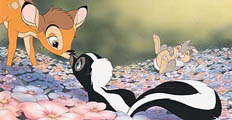
![]() Animators faced
a huge dilemna with Bambi, as they could not figure out for a long
time how to inject life into real-looking animals, and make them interesting
enough to carry a full-length feature. Their problem was solved the
day Frank Thomas and Ollie Johnston heard the voice of a young boy who
was being interviewed for the voice of Thumber the bunny -he gave them
a totally new take on the picture, by inspiring them to think of the young
animals as kids in the neighborhood. Though the casting director
thought that this young boy was horribly talentless, the main animators
insisted that he be hired for the role of Thumper -which he was!
Animators faced
a huge dilemna with Bambi, as they could not figure out for a long
time how to inject life into real-looking animals, and make them interesting
enough to carry a full-length feature. Their problem was solved the
day Frank Thomas and Ollie Johnston heard the voice of a young boy who
was being interviewed for the voice of Thumber the bunny -he gave them
a totally new take on the picture, by inspiring them to think of the young
animals as kids in the neighborhood. Though the casting director
thought that this young boy was horribly talentless, the main animators
insisted that he be hired for the role of Thumper -which he was!
![]() Bambi was
started before Pinocchio and Fantasia,
but released after these two: by the time it reached the screen, the armed
forces were already depleting the Studio's ranks. For a while, the
Studio would have to coast - capitalizing on its past achievements, working
well within its capabilities, experimenting a little, and waiting for energies
to be restored.
Bambi was
started before Pinocchio and Fantasia,
but released after these two: by the time it reached the screen, the armed
forces were already depleting the Studio's ranks. For a while, the
Studio would have to coast - capitalizing on its past achievements, working
well within its capabilities, experimenting a little, and waiting for energies
to be restored.
![]() Some scenes of
woodland creatures and the forest fire are unused footage from
Pinocchio.
Some scenes of
woodland creatures and the forest fire are unused footage from
Pinocchio.
![]() Walt Disney brought
in live fawns in order to study the movements and make the film more life
like.
Walt Disney brought
in live fawns in order to study the movements and make the film more life
like.
![]() Four different actors
provided the voice of the title character.
Four different actors
provided the voice of the title character.
![]() Young Bambi's
spots are always changing! In shapes and numbers. For example, Bambi starts
off with about 7, he goes down to about 5 in the next scene, goes up to
about 8, etc. His girlfriend's eyes also change color throughout
the film.
Young Bambi's
spots are always changing! In shapes and numbers. For example, Bambi starts
off with about 7, he goes down to about 5 in the next scene, goes up to
about 8, etc. His girlfriend's eyes also change color throughout
the film.
![]() Bambi is
the non-musical animated movie with the fewest line of dialogue ever!
Bambi is
the non-musical animated movie with the fewest line of dialogue ever!
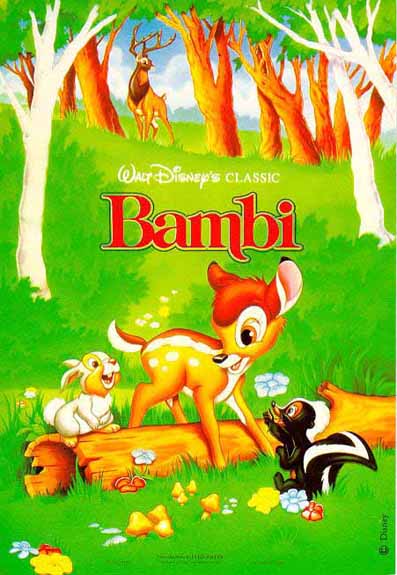
![]() When originally
released in 1942, Bambi was recorded in monaural (even after the
breakthrough of stereo sound, pioneered by Disney's own Fantasia
two years earlier).
When originally
released in 1942, Bambi was recorded in monaural (even after the
breakthrough of stereo sound, pioneered by Disney's own Fantasia
two years earlier).
![]() In the United
States there was some controversy surrounding the Disney version of the
film at its first appearance. The story depicts human hunters in rather
negative perspective. Thus the American Rifleman's Association made a public
statement against the film's depiction of hunters and asked that the film
be prefaced with a pro-hunting statement.
In the United
States there was some controversy surrounding the Disney version of the
film at its first appearance. The story depicts human hunters in rather
negative perspective. Thus the American Rifleman's Association made a public
statement against the film's depiction of hunters and asked that the film
be prefaced with a pro-hunting statement.
![]() The movie was
Oscar-nominated for Best Song, Best Score and Best Sound. It is also
said to be Walt Disney's favorite.
The movie was
Oscar-nominated for Best Song, Best Score and Best Sound. It is also
said to be Walt Disney's favorite.
![]() It was revealed
in March 2002 that Disney considers producing a computer-generated sequel
to Bambi! The Los Angeles Times confirmed a year later, in February
2003, that art director Carol Kieffer Police would be playing a significant
role "in the upcoming Disney feature Bambi and the Great Prince,
doing character and costume design as well as location and color styling."
However, Jim Hill revealed in May 2003 that Bambi 2 was on hold
on hold for a year or two until enough advances could be made in computer
animation so that it actually looked like the original animated films.
"Disney Television Animation is still trying to decide whether or not it
wants to go forward with [this] CG sequel."
It was revealed
in March 2002 that Disney considers producing a computer-generated sequel
to Bambi! The Los Angeles Times confirmed a year later, in February
2003, that art director Carol Kieffer Police would be playing a significant
role "in the upcoming Disney feature Bambi and the Great Prince,
doing character and costume design as well as location and color styling."
However, Jim Hill revealed in May 2003 that Bambi 2 was on hold
on hold for a year or two until enough advances could be made in computer
animation so that it actually looked like the original animated films.
"Disney Television Animation is still trying to decide whether or not it
wants to go forward with [this] CG sequel."
![]() 9-year-old Alexander
Gould (Finding Nemo) revealed in a June 2003 interview that he would
voice Bambi in the CG sequel.
9-year-old Alexander
Gould (Finding Nemo) revealed in a June 2003 interview that he would
voice Bambi in the CG sequel.
 |
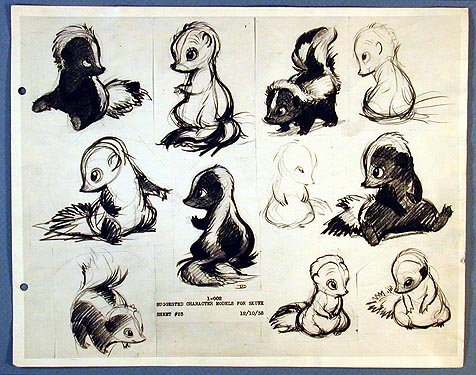 |
 |
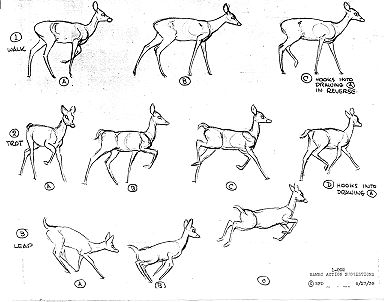 |
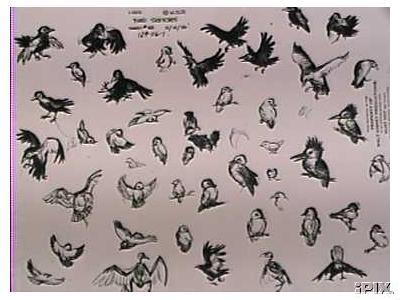 |
Walt Disney began development of Bambi in 1936, and for the next six years, a select team labored to merge the reality of nature and the fantasy of animation. Live animals were brought into the Disney Studio (Disney kept two live deer on hand for the animators to study), natural science lectures were given, nature photos adorned office walls, and hundreds of thousands of sketches, drawings, paintings, and tests were made. There, in the infancy of the animation medium, Disney and his staff attempted to adapt and acknowledged literary masterpiece, while bringing a level of reality to a medium that had barely proven itself capable of telling stories over seven minutes long.
"How could we animate the scenes in the book?" recalled legendary Disney animators Frank Thomas and Ollie Johnston. "When we read Bambi and looked at him, filled with a wonderful ecstasy, and shaken by a mysterious tremor, we found nothing we could draw. Inner feelings were beyond our abilities at the time -- far beyond; yet Walt seemed resolved to go ahead."
So, for a period of years, the Disney staff met this challenge. Bambi
was distinguished by a magnitude of masterly production art -- from the
inspirational
sketches and background paintings keyed by Tyrus Wong ("He shows you
less of what you would see and more of what you feel looking at a forest,"
said animation authority Charles Solomon), to animation drawings that display
some of the finest draftmanship in the history of the medium by Marc Davis,
Frank Thomas, Ollie Johnston, Milt Kahl, and Eric Larson. Bambi
led to the execution of some of the most striking and beautiful art ever
created by the Disney Studio.
|
||||||||||||